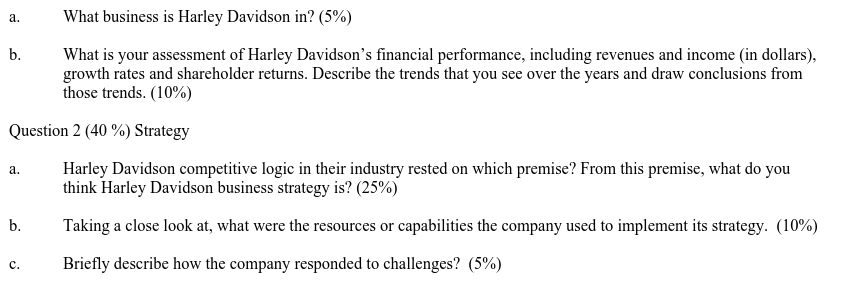Question
Harley davidson case The Great Recession hit Harley-Davidson hard. During the fourth quarter of 2008, Harleys global sales dropped 13 percent, profits decreased by 30

Harley davidson case

The Great Recession hit Harley-Davidson hard. During the fourth quarter of 2008, Harleys global sales dropped 13 percent, profits decreased by 30 percent for the year, and, over a 12-month period, its stock price plummeted 70 percent.1 Harley had not confronted a drop in sales and profits of this magnitude since the early 1980s, when it barely avoided bankruptcy as a subsidiary of VMF. But, fortunately for Harley, it faced the new challenge with resources that it simply didnt have 30 years earlier. By 2016, the Harley bar and shield logo, a symbol of American individualism, was the 80th most valuable global brand, with an estimated value of $5.5 billion.2 The brand sold not only motorcycles, but also a wide variety of merchandise. Moreover, the Harley Owners Group (HOG) was the largest motorcycle enthusiast organization in the world, with almost 1 million members. The Harley brand with its loyal customer base, combined with an increase in consumer confidence, helped boost sales to $6 billion in 2015.3 Despite the recent rebound in revenues and earnings, Harleys sales were still almost $300 million lower than they were in 2008. The challenge of flat to declining sales, even in a good economy, had Harley Davidson CEO Matt Levatich and his team concerned about whether Harley could grow during the next decade the way it had in the previous decade.
Traditional riders, Caucasian men ages 35 to 74, had represented the largest portion of Harleys retail sales for many years.4 And, although this demographiccoming in at around 50 million people5was expected to remain stable from 2013 through 2050, the baby boomers who had grown up with the Harley brand were aging, with fewer riding motorcycles each year. Moreover, many questioned whether Harley-Davidson could grow outside its traditional customer base. Harley had struggled for decades trying to sell to nontraditional riders, including young adults (ages 1835), women, Hispanics, and African Americansfour groups that together are three times larger than the number of traditional riders.6 A survey done by Harley-Davidson revealed that young adults found the dealership experience intimidating and tended to have sticker shock when seeing the price of a Harley.7 Furthermore, some critics blamed the bikes reputation and size (average weight between 450 to 800 pounds) for Harleys lack of popularity among women.8 Investors were looking for continued growth, so they wanted to know what Harley was going to do to expand into other demographics.9 Likewise, they wanted to know if the American motorcycle could improve sales in international markets.
y 1931, the US motorcycle industry had consolidated and was dominated by Harley-Davidson, Indian, and British Triumph. By the mid-1950s, Harley had a commanding 60 percent share of the market,19 was the only American manufacturer of motorcycles, and dominated the motorcycle racing world. But the competition was about to hit the throttle. Honda Motor Company had successfully broken away from its competitors Yamaha, Kawasaki, and Suzuki, after producing the incredibly successful 50 ccII lightweight delivery motorcycle, which sold 3,000 units per month only six months after being introduced to the market.20 After investing in a 30,000-unit-per-month manufacturing plant, a capacity 10 times in excess of demand at the time of construction, Honda looked to the United States for growth opportunities. In 1959, Honda Motor Company, already the largest motorcycle producer in the world, entered the American motorcycle market. Starting on the west coast of the United States, Honda moved eastward region by region, developing the market. It concentrated its marketing efforts on the middle-class consumer and branded itself as the family-friendly bike. The ad campaign, You meet the nicest people on a Honda, was a direct contrast to the rough, aggressive, and loud image of the American Harley-Davidson. Hondas growth pattern was subtle. When entering a new market, Honda did so with its lightweight 50 cc bikes, which weighed 150200 pounds and sold for less than $250 retail, a significant drop in weight and price compared to Harley motorcycles, which weighed between 450 and 800 pounds and retailed between $1,000 and $1,500.21 Not only were the bikes smaller, quieter, and more fuel-efficient than the heavyweight Harleys, but they also required little or no maintenance because of Hondas large and standardized production process. As a result, Honda was able to offer a better-built motorcycle at a fraction of the cost. A study done by the Boston Consulting Group in 1975 showed that Harleys prices were dropping by roughly 15 percent with each doubling of volume
a. What business is Harley Davidson in? (5\%) b. What is your assessment of Harley Davidson's financial performance, including revenues and income (in dollars), growth rates and shareholder returns. Describe the trends that you see over the years and draw conclusions from those trends. (10%) Question 2(40%) Strategy a. Harley Davidson competitive logic in their industry rested on which premise? From this premise, what do you think Harley Davidson business strategy is? (25%) b. Taking a close look at, what were the resources or capabilities the company used to implement its strategy. (10\%) c. Briefly describe how the company responded to challenges? (5%) a. Provide a SWOT analysis of Harley Davidson (20\%) Question 5. What recommendations would you make to new CEOs, to continue Harley Davidson track record of successStep by Step Solution
There are 3 Steps involved in it
Step: 1

Get Instant Access to Expert-Tailored Solutions
See step-by-step solutions with expert insights and AI powered tools for academic success
Step: 2

Step: 3

Ace Your Homework with AI
Get the answers you need in no time with our AI-driven, step-by-step assistance
Get Started


